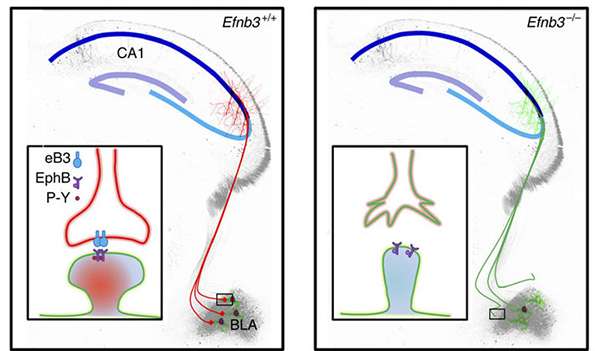Where does innate fear come from?

The 20th century has seen an explosion of scientific efforts made to reveal the biological substrates of cognitive functions. Emotions and cognitive processes interact to build up complex behavioural responses and to drive environmental adaptations. Fear, one of our noble and sophisticated brain functions, requires a perfect integration of emotional and cognitive inputs. Memory, leaning and emotions play altogether to shape our actions. As mentioned by Gabriel Gasque, Associate Editor of PLOS Biology, "Cognition – the term that includes mental processes such as attention, memory, problem-solving, planning, and language – stopped being exclusively a philosophical subject approached by introspection and became a matter of empirical investigation and objective quantification".
In a research article published in Nature Communications, Zhu and authors explored the mechanisms required for normal development of the amygdala, a brain region highly involved in emotions, fear and memory. In fact, the amygdala must be considered as a sensory hub for the integration of emotional stimuli. Thus, understanding neural circuits underlying emotional and cognitive states is fundamental since dysfunctions of early emotional circuits may lead to neurodevelopmental disorders such as autism and schizophrenia.
Among all the biomolecules able to promote or interfere with emotional and cognitive functions, ephrins and their specific receptors play a major role in modulating brain plasticity and sensory integration. Ephrins are membrane-bound proteins that act as ligands of Eph receptors and have been extensively documented as fundamental for axon guidance. In addition, ephrins have also been shown to be key actors in cellular phenomena such as axon pruning, synaptogenesis, synaptic and structural plasticity. At the behavioural level, ephrin-B3 (eB3) has also been found to be associated with anxiety disorders and mental retardation.
Using specific gene-targeted mice, Zhu and authors observed that ephrin-B3 is required during a critical period in the neonatal brain for axon targeting and dendritic spine formation in the amygdala and for the development of innate fear. In particular, "we found that eB3 deletion leads to a significant defect in innate fear behaviour, which is associated with a disruption in connections of amygdala neurons", says Xiao-Na Zhu, the leading author of the study. The results are in agreement with the authors' hypothesis that eB3 stimulates forward signaling to guide axon targeting for trans-nucleus modulation (from hippocampus to amygdala) and thereby coordinates spinogenesis and neuronal activation in the amygdala. Thus, according to their results, eB3 may act by allowing pre- and post-synaptic structures interacting and thereby coordinates axon targeting, morphology and neuronal reactions in the amygdala.
Interestingly, eB3 is observed mainly in the hippocampus (a memory-related area) but not in the amygdala (a fear-related area), raising then the question of how eB3 in these structures may initiate molecular reactions to modify amygdala through wired trans-nucleus synapses. "Mechanistically", propose the authors, "phosphorylated EphB receptors can regulate GluN1 receptor-dependent influx of calcium, leading to synaptic function-related gene expression which eventually facilitates spine morphogenesis and hence neuronal reactions to aversive cues".
The brain elicits innate fear-driven responses by integrating sensory stimuli with critical brain nuclei that are involved in the initiation and modulation of amygdala-mediated emotional responses. The authors argue that because aberrant wiring of emotional circuits could lead to neurodevelopmental disorders characterized by socio-emotional impairments, these results could explain why deficiencies in Ephrin-B/EphB signaling have been linked to anxiety disorders and autism.
There is no need to say that further investigations will be necessary to fully uncover the biological substrates by which our brain, especially during development, integrates sensory inputs, computes and elaborates them in order to build up complex behaviors.
More information: Xiao-Na Zhu et al. Ephrin-B3 coordinates timed axon targeting and amygdala spinogenesis for innate fear behaviour, Nature Communications (2016). DOI: 10.1038/ncomms11096
This story is republished courtesy of PLOS Blogs: blogs.plos.org.




















